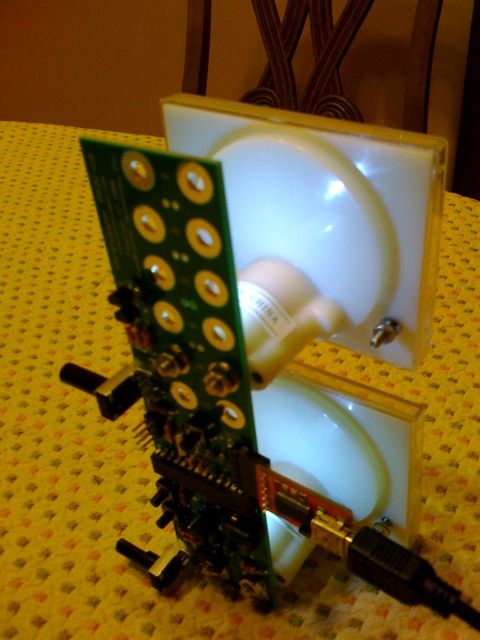Chronulator 2.0 Number 1
So here it is, Chronulator 2.0 number 1, photographed on the ShareBrained trademark kitchen tablecloth. It went together well, with just a couple of tweaks.

First, I forgot/neglected to connect power between the ISP port and the AVR chip. That's no big deal for the 95% of people who don't need to load their own bootloader. But it should work, so I'll make it work by revising the circuit board.
Second, the circuit board holes on the quartz crystal were too close together. Therefore, there was no room for the solder mask treatment between the solder pads. And that made it hard NOT to create a solder bridge between the two pads, which would make the Chronulator not work. So I'm going to change the board to put some more space between the pads – enough to get a thread of solder mask in there…
I made these changes and will submit the new final design for manufacture tomorrow. I'm going to grit my teeth and pay for one-week turnaround. It adds about $1 to the cost of the kit, but will allow me to ship kits a week earlier (the plan now is to ship the first round of orders on December 8th). People love to give (and get!) Chronulators as gifts, so the sooner I can get them on sale, the better!
OK, with the details out of the way, I want to explain a couple of new things about the design:
First, the Chronulator 2.0 now uses the Atmel ATmega168, the same chip in the popular Arduino device. I've also included a port for an add-on USB-to-serial adapter (the SparkFun FTDI basic breakout board), through which you can program, control, and hack your Chronulator using the Arduino software. You can also power the Chronulator from the USB port, if you want to use your Chronulator with your computer.
Notice the lights on the meters? I've put places on the board for you to add high-power LEDs you can use to illuminate your meters. My experiments thus far making transparent meter labels have been not-so-successful, but I'm hoping my talented and creative customers can come up with some clever solution.
There are also spare pins you can connect to on the board. You can use these extra pins to control additional LEDs, another meter (for a "seconds" hand), or hook up to external devices like an atomic clock receiver module, GPS, various analog signals… Who knows? I'll be posting the results of some of my hacking experiments. I hope you'll do the same as you experiment with YOUR Chronulator!
Comments
We want to order!!! :-)